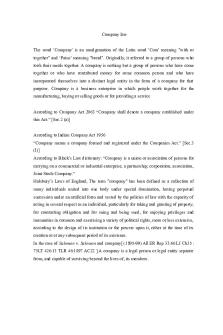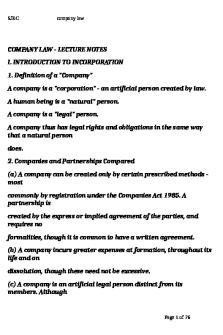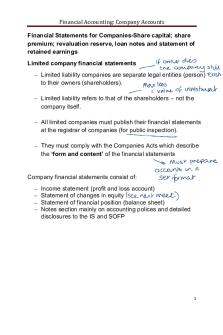Company staff - Lecture notes 3-4 PDF

| Title | Company staff - Lecture notes 3-4 |
|---|---|
| Course | Entrepreneurship |
| Institution | University of Bath |
| Pages | 7 |
| File Size | 151.8 KB |
| File Type | |
| Total Downloads | 8 |
| Total Views | 158 |
Summary
Christof Lutteroth
...
Description
Topic 3. Company staf A.Company staff structure. 1. What is a company staff structure / organizational structure? a. Organizational structure is a system that consists of explicit and implicit institutional rules and policies designed to outline how various work roles and responsibilities are delegated, controlled and coordinated. Organizational structure also determines how information flows from level to level within the company. For example, in a centralized structure, decisions flow from the top down, while in a decentralized structure, the decisions are made at various different levels. b. An organizational structure defines how activities such as task allocation, coordination and supervision are directed toward the achievement of organizational aims. c. Organizational structure can also be considered as the viewing glass or perspective through which individuals see their organization and its environment d. Organizational structure, stated simply, defines a specific hierarchy within an organization, and businesses of all shapes and sizes use it heavily. A successful organizational structure defines each employee's job and how it fits within the overall system. This structuring provides a company with a visual representation of how it's shaped and how it can best move forward in achieving its goals. Organizational structures are normally illustrated in some sort of chart or diagram.
2. Why a company needs an organizational structure? Organizational structure affects organizational action in two ways: it provides the foundation on which standard operating procedures and routines rest. it determines which individuals get to participate in which decision-making processes, and thus to what extent their views shape the organization’s actions. 3. Flat Vs. Hierarchical Organizational Structure – Two most common arrangements; the most appropriate arrangement will depend on the size and type of your business, and the number of management levels that you need. a. Hierarchal organizational structure - Hierarchical structure is typical for larger businesses and organisations. A hierarchical structure business has a 'tall' hierarchy - i.e. multiple layers and a longer 'chain of command'. Employees are ranked at many different levels within the organisation; each level is one above the other. Resembling a pyramid, this structure gets wider as you move down - usually with one chief executive at the top, followed by senior management, middle managers and finally workers. Employees’ roles are clearly defined within the organisation, as is the nature of their relationship with other employees. of a hierarchical structure The advantages business are: 1. authority and responsibility are clear and well defined
2. opportunities for promotion motivates employees 3. employees can specialise and develop expertise in their field The disadvantages of a hierarchical structure are: 1. communication between different departments may be less effective 2. bureaucracy can slow down decision making 3. it may be more difficult for the business to adapt and change 4. there could be rivalry between departments leading to decisions that benefit one team, instead of the organisation as a whole b. Flat organizational structure - A flat structure means that the business either has no management layers or the 'chain of command' is very short and staff level employees all report to one overall manager. This type of structure works in small businesses and those that need to be very flexible. The advantages of a flat organisational structure are: 1. better communication and relationships between different roles 2. simple, faster decision making processes 3. it is easier for the business to change and adapt 4. increase in employee responsibility levels The disadvantages of a flat organisational structure are: 1. confusion when employees don’t report to a specific manager 2. lack of employee specialism and specific job functions 3. lack of long-term growth or opportunity for promotion 4. difficulties in scaling up and growing the company 4. Common types of Organizational Structures (pre-bureaucratic structures, bureaucratic structures, post-bureaucratic structures, functional structures, divisional structures, matrix structures) At its highest level, an organizational structure is either centralized or decentralized. Traditionally, organizations have been structured with centralized leadership and a defined chain of command. The military, for example, is an organization famous for its highly centralized structure, with a long and specific hierarchy of superiors and subordinates. However, there has been a rise in decentralized organizations, as is the case with many technology start-ups. This allows the companies to remain fast, agile and adaptable, with almost every employee receiving a high level of personal agency. o Historical evolution and the modern structures o Four types of common organizational structures are implemented in the real world. The first, and most common, is a functional structure. This is also referred to as a bureaucratic organizational structure
and breaks up a company based on the specialization of its workforce. Most small-to-medium sized businesses implement a functional structure. Dividing the firm into departments consisting of marketing, sales and operations is the act of using a bureaucratic organizational structure. o The second type is common among large companies with many business units. Called the divisional or multi-divisional structure, a company that uses this method structures its leadership team based on the products, projects or subsidiaries they operate. A good example of this structure is Johnson & Johnson. With thousands of products and lines of business, the company structures itself so each business unit operates as its own company with its own president. o Flatarchy, a newer structure, is the third type and is used among many start-ups. As the name alludes, it flattens the hierarchy and chain of command and gives its employees a lot of autonomy. Companies that use this type of structure have a high speed of implementation. o The fourth and final organizational structure is a matrix structure. It is also the most confusing and the least used. This structure matrixes employees across different superiors, divisions or departments. An employee working for a matrixed company, for example, may have duties in both sales and customer service. o Other structures – the traditional hierarchy, flatter organizations, flat organizations, Holarctic organizations, organizational circle, team, network, virtual and others. B.Staff recruitment, training and development
1. Human Resources (HR) - the company department charged with finding, screening, recruiting and training job applicants, as well as administering employee-benefit programs. As companies reorganize to gain competitive edge, human resources play a key role in helping companies deal with a fastchanging environment and the greater demand for quality employees. A human resources department is an essential, if not critical, component of any business regardless of the organization's size. It is primarily focused on maximizing employee productivity and protecting the company from any issues that may arise from the workforce. HR responsibilities include compensation and benefits, recruitment, firing and keeping up to date with any laws that may affect the company and its employees. 2. Essential Functions of HR o Effectively managing and utilizing people. o Tying performance appraisal and compensation to competencies.
o Developing competencies that enhance individual and organizational performance. o Increasing the innovation, creativity and flexibility necessary to enhance competitiveness. o Applying new approaches to work process design, succession planning, career development and interorganizational mobility. o Managing the implementation and integration of technology through improved staffing, training and communication with employees. HR departments are expected to perform human resource management (HRM) strategies. HRM is a strategic and comprehensive approach to managing employees and the organizational culture and environment. It focuses on the recruitment, management and general direction of the people who work in an organization. HR is also more involved in improving the organization’s workforce by recommending processes, approaches and business solutions to management. For example, in IKEA, HR shifted its focus on values and cultural fit rather than skills and experience in recruiting employees. 3. Staff recruitment - a core function of human resource management. It is the
first step of appointment. Recruitment refers to the overall process of attracting, shortlisting, selecting and appointing suitable candidates for jobs (either permanent or temporary) within an organization. Recruitment can also refer to processes involved in choosing individuals for unpaid positions, such as voluntary roles or unpaid trainee roles. Managers, human resource generalists and recruitment specialists may be tasked with carrying out recruitment, but in some cases public-sector employment agencies, commercial recruitment agencies, or specialist search consultancies are used to undertake parts of the process. Internet-based technologies to support all aspects of recruitment have become widespread. 4. Process of staff recruitment o Job analysis o Sourcing o Screening and selection o Disabled candidates o Diversity o Recruitment process outsourcing (RPO) 5. Approaches 6. Multi-Tier Recruitment Model An example of a 3 tier recruitment model:
Tier 1 - Contact/ Help desk - This tier acts as the first point of contact where recruitment requests are being raised. If the requests are simple to fulfil or are queries in nature, resolution may take place at this tier Tier 2 - Administration - This tier manages mainly the administration processes Tier 3 - Process - This tier manages the process and how the requests get fulfilled
7. Training and Development - Training and development describes the formal, ongoing efforts that are made within organizations to improve the performance and self-fulfilment of their employees through a variety of educational methods and programs. In the modern workplace, these efforts have taken on a broad range of applications—from instruction in highly specific job skills to long-term professional development. In recent years, training and development has emerged as a formal business function, an integral element of strategy, and a recognized profession with distinct theories and methodologies. More and more companies of all sizes have embraced "continual learning" and other aspects of training and development as a means of promoting employee growth and acquiring a highly skilled work force. In fact, the quality of employees and the continual improvement of their skills and productivity through training, are now widely recognized as vital factors in ensuring the long-term success and profitability of small businesses 8. Differences between training and development o Short term vs. Long term - Some human resource experts explain the differences between training and development very simply: the first thinks about the present and the second about the future. In general, training faces an immediate challenge and teaches the knowledge or skills needed by company employees in a short period of time (one day, one week, several months). It is all about “here and now”. It could be a course to improve the communication skills of employees, a conference to explain the protocol for returning a product or a class to use the Excel program. On the other hand, development focuses on the long term. Human resource managers propose a strategy to put in place over several months or years, comprising a set of initiatives that are expected to bear fruit over a long period of time. It is a continuous process in which you are trying to develop professionals in their next step or their next position of responsibility. o Job position vs. Professional career - Due to its precision and commitment to the short term, training is designed for a specific job position. It seeks to provide professionals with tools and skills, taking into account the work that they will be doing at the company. However, development focuses on the person: its objective is to get the best out of each professional in the company, identifying their interests and the fields in which they can more easily progress. If training focuses on a job position, development puts the emphasis on building a successful professional career. o Specific objectives vs. Open objectives - In training, the objectives are specific and well defined: learning how to use a program, obtaining a certain personal skill or teaching the new protocols put in place by the company. When we talk about development however, the objectives are always much broader and can cover all types of knowledge and skills. Compared to training, development is less tangible and often focuses on philosophical issues, changing habits and improving skills. Not only that, but objectives can be changed over time and completed according to the new demands of the market or the company.
o Group vs. Individual - Training tends to be an initiative designed by a company and taught by a tutor or expert. The company pays for the expenses and organizes the courses, decides what sort of tools its employees should use, and sets the guidelines to follow in all the training activities. These initiatives are often taught in a group (a department, people who have recently joined the company, etc.). However, with development, the emphasis is put on the individual. Development programs are often personalized and the person who is ultimately responsible is the employee. In this case, the most important focus is not on lessons taught by a tutor, but rather on the self-learning process and progress that must be taken on by the professional....
Similar Free PDFs

Day 34 - Lecture notes Day 34
- 12 Pages

Exponentials - Lecture notes 34-48
- 12 Pages

Company Law Lecture Notes
- 56 Pages

Company law lecture notes
- 9 Pages

COMPANY LAW -LECTURE NOTES
- 48 Pages

Company Law Lecture Notes
- 60 Pages

You-Forever - Lecture notes 34
- 204 Pages

PLAN 34 pdf - Notes de cours 34
- 2 Pages
Popular Institutions
- Tinajero National High School - Annex
- Politeknik Caltex Riau
- Yokohama City University
- SGT University
- University of Al-Qadisiyah
- Divine Word College of Vigan
- Techniek College Rotterdam
- Universidade de Santiago
- Universiti Teknologi MARA Cawangan Johor Kampus Pasir Gudang
- Poltekkes Kemenkes Yogyakarta
- Baguio City National High School
- Colegio san marcos
- preparatoria uno
- Centro de Bachillerato Tecnológico Industrial y de Servicios No. 107
- Dalian Maritime University
- Quang Trung Secondary School
- Colegio Tecnológico en Informática
- Corporación Regional de Educación Superior
- Grupo CEDVA
- Dar Al Uloom University
- Centro de Estudios Preuniversitarios de la Universidad Nacional de Ingeniería
- 上智大学
- Aakash International School, Nuna Majara
- San Felipe Neri Catholic School
- Kang Chiao International School - New Taipei City
- Misamis Occidental National High School
- Institución Educativa Escuela Normal Juan Ladrilleros
- Kolehiyo ng Pantukan
- Batanes State College
- Instituto Continental
- Sekolah Menengah Kejuruan Kesehatan Kaltara (Tarakan)
- Colegio de La Inmaculada Concepcion - Cebu







